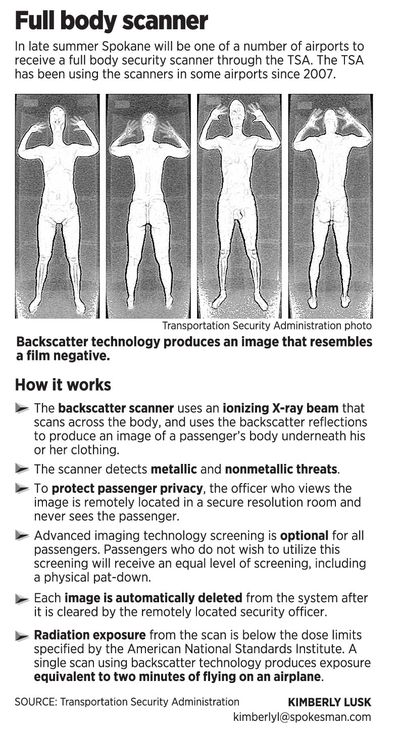Spokane airport awaits body scanner
Image checkers won’t see passengers

By late summer, travelers flying out of Spokane International Airport may be more conscious of their underwear, but the tradeoff could be increased safety.
That’s when Spokane is expected to get a full body “backscatter” scanner from the federal Transportation Security Administration for use in airport security. The machine works by projecting an ionizing X-ray beam over the surface of the body at high speed. The “backscatter” of the beam reflects a black-and-white image onto a monitor that looks more like a chalk sketch of the human form than it does a medical X-ray.
But full body scanners have been controversial, with passengers nationally raising concerns about privacy and safety.
Spokane resident Ben Grubert had mixed opinions on the new technology. He has not been through a full body scanner but would be interested to see one, he said at the airport last week.
“I’m concerned about the invasiveness,” Grubert said. “If people could view my wife in a way that would dishonor her, I wouldn’t want her subject to that.”
The scanner images are viewed in an isolated location, such as a separate office. TSA personnel who assist passengers are not allowed to see the scans, and those checking scans are not to see the passengers.
TSA personnel communicate through a wireless headset to move passengers through the scan. The images cannot be stored or printed, according to the TSA’s website.
Todd Woodard, spokesman for Spokane International Airport, said the TSA will decide where the Spokane scanner will be used. The airport has two screening areas, one at Concourse A/B and the other at Concourse C. Installing the machine should only result in “minor modifications to existing space and utilities,” he said.
Some passengers have expressed concern about radiation exposure, but officials say the doses are insignificant.
“All results confirmed that radiation doses for people being screened as well as operators and bystanders were well below dose limits specified by the American National Standards Institute,” said Dwayne Baird, a regional TSA spokesman.
Drew Thatcher, certified health physicist with the Washington state Department of Health, said people are already exposed to a certain amount of radiation from their environment, buildings and food.
“The exposure from the scan is less than 1 percent of daily background radiation exposure in the Spokane area,” he said.
Travelers uncomfortable with the scanner can opt to go through a traditional screening check, including a pat-down, Baird said.
In the pilot test conducted by the TSA, fewer than 1percent of passengers opted to go through a traditional security check rather than the full-body scanner, he said.
He added that the new technology is a benefit for people who have medically implanted devices, such as pacemakers or knee replacements. When they go through a traditional airport security check, they set off metal detectors and get a full pat-down, but with the new scanners, they can be through in two to four seconds, Baird said.
The first full body scanners were installed in the U.S. in 2007 and are used in 29 airports across the country.
The TSA uses two models, the backscatter and the millimeter wave, which projects an image through use of electromagnetic waves. They are different technologies manufactured by different companies, but both identify metallic and nonmetallic threats, Baird said. Space constraints at individual airports dictate what kind of machine they get, Baird said.
The machines cost $130,000 to $170,000 each; the TSA is funding the placement of the scanners through the American Recovery and Reinvestment Act.
In Spokane, traveler Willie Wilson, from Nicaragua, said last week he has heard about people who were embarrassed or uncomfortable going through the scanners.
But, “Overall it’s a good idea because it allows for a flow of traffic,” he said. “It keeps security at the level we’re trying to achieve.”